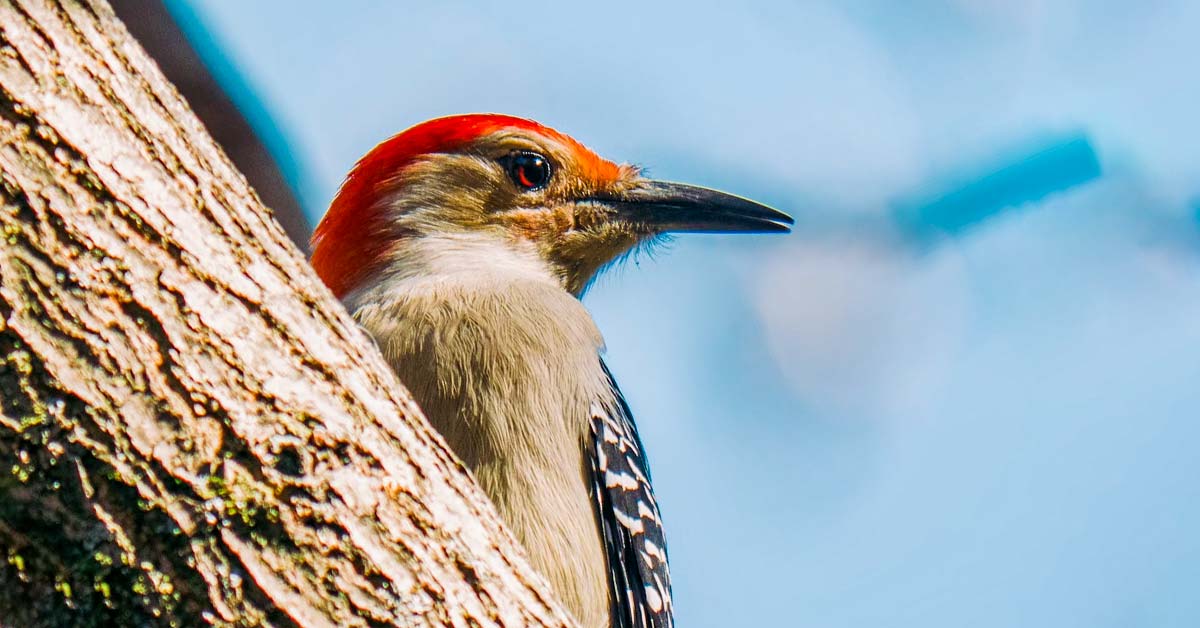There are eight species of woodpeckers in Virginia, each with its own unique look and personality.
Whether you’re new to birdwatching and want to visit the state for some wholesome birding in Virginia, or you live here and want to learn more about a woodpecker that visited your backyard recently, this post should be an interesting read for you.
8 Woodpeckers in Virginia
You can find Downy Woodpecker, Pileated Woodpecker, Red-bellied Woodpecker, Yellow-bellied Sapsucker, Red-cockaded Woodpecker, Northern Flicker, Hairy Woodpecker, and Red-headed Woodpecker in Virginia.
Some are more active (and aren’t shy even with humans nearby), but others are only spotted rarely.
1. Downy Woodpecker (Dryobates pubescens)

The Downy Woodpecker is Virginia’s smallest woodpecker.
It is between the size of a robin and sparrow, but they’re quite brave (not afraid of people) and easy to spot.
If you hear a woodpecker sound pecking on wood, it’s highly likely that it is the downy woodpecker since it is the most common in Virginia.
Downy Woodpecker Appearance
Regardless of gender, these tiny birds have black and white plumage with a white chest and spotted wings.
However, male downy woodpeckers have a small red patch on their caps.
Where to find Downy Woodpeckers in Virginia
Downy Woodpeckers live all over Virginia year-round. They are usually found in backyard gardens, edges of forests, and woodlands, thriving both in rural and urban areas.
In winter when many birds head south, the Downy Woodpeckers stay put in Virginia and spend their winters here.
2. Pileated Woodpecker (Dryocopus pileatus)
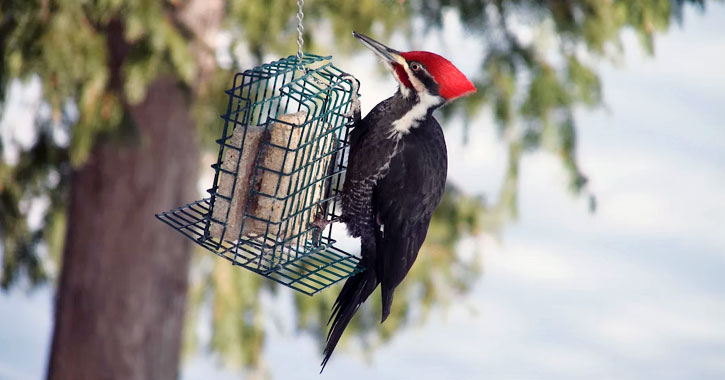
The Pileated Woodpecker is exceptionally easy to spot – just look at its appearance!
It is the largest woodpecker not only in Virginia, but also the entire country.
Not only does this woodpecker have a striking look, it is also very loud with mating cries and wood rapping heard all over Virginia.
Pileated Woodpecker Appearance
The Pileated Woodpecker mostly has black plumage, but the most notable feature is the bold red crest and white stripes on its face. It has thin beaks and males have a marking that looks like a mustache.
It is also a huge bird – about the size of a crow, so when you see one on a tree, even a non-birder can easily identify that it’s a Pileated Woodpecker.
The Pileated Woodpeckers used to be confused with the Ivory Billed Woodpecker, but since the latter is already extinct, this isn’t a problem anymore.
Where to find Pileated Woodpeckers in Virginia
Pileated Woodpeckers are observed in Virginia year-round.
They’re not super-picky when it comes to their habitats, but they prefer old forests and areas with decaying or dead trees where they feast on ants and other small insects.
3. Red-bellied Woodpecker (Melanerpes carolinus)
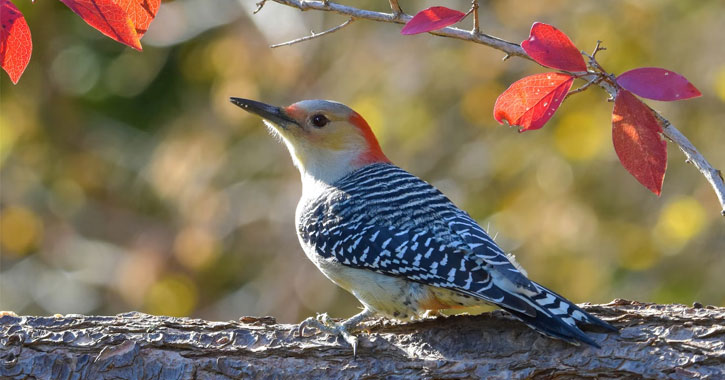
Many people expect the red-bellied woodpecker to have a fully vibrantly red belly, but this bird actually doesn’t hold true to its name.
Yes, there’s a tinge of red on these birds bellies, but the pale yellow bellies catch many people off guard.
Red-bellied woodpeckers are easier identified by ear- they have a distinct rolling call that loudly and frequently echoes in forests during the spring and summer.
Red-bellied Woodpecker Appearance
Red-bellied woodpeckers have black and white striped backs, a pale orange-tinted underpants with bright red napes and heads.
Unlike other birds (where males have red caps), it is almost impossible to differentiate these woodpeckers between genders.
Where to find Red-bellied Woodpeckers in Virginia
The red-bellied woodpecker is a common bird found all over Virginia.
They enjoy visiting backyard feeders and build their nests in groves, woodlands, forests, and just about any area full of dead wood where they could easily forage for seeds, nuts, berries, and insects.
If you discover a red-bellied woodpecker in a spot in the forest, it would likely still be there on your next visit since they don’t love moving around much.
4. Yellow-bellied Sapsucker (Sphyrapicus varius)
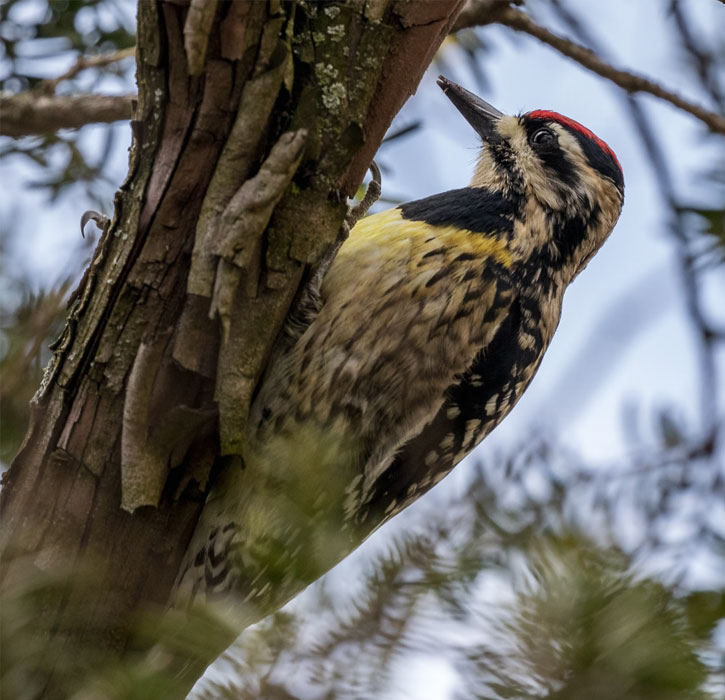
Yellow-bellied Sapsuckers are known for two things:
- Creating uniform, neatly-spaced tiny holes in trees
- The recognizable, unique sound of their drilling, compared to the common pecking sound of woodpeckers
Yellow-bellied Sapsucker Appearance
It’s totally the opposite of red-bellied woodpecker above that doesn’t have an all-red belly… the Yellow-bellied Sapsuckers feature a distinctive bright-yellow chest to belly.
They also have red-tinged nape, a red crown, black and white specks from head to wings to toe.
The main difference between males and females aren’t seen in the red head (all Yellow-bellied Sapsuckers have red heads regardless of gender).
Instead, the male throats are colored bright red, while female throats are white.
Where to find Yellow-bellied Sapsuckers in Virginia
Yellow-bellied sapsuckers are considered the most migratory woodpeckers in the world.
Unlike other woodpeckers in Virginia, Yellow-bellied Sapsuckers only get spotted during winter and colder months. They stay in Virginia during non-breeding seasons.
They also nest and peck wood at extremely high trees (often above 6,000 feet), making them difficult to spot.
5. Red-cockaded Woodpecker (Dryobates borealis)
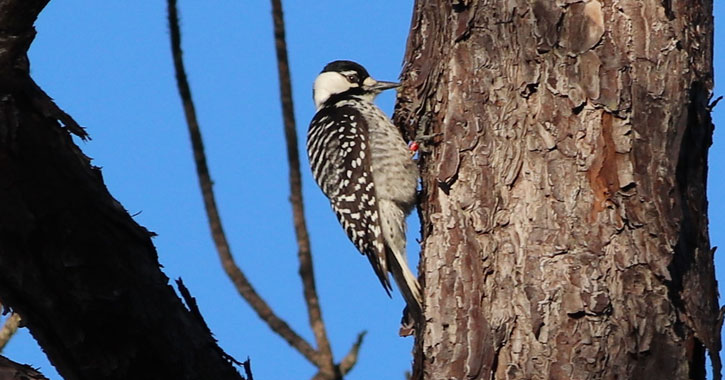
This bird is another one with a misleading name.
Red-cockaded woodpeckers are named for the line of red feathers between their black caps and white cheeks, but not all of them have red in their feathers. It is an exclusive feature on males.
Red-cockaded Woodpecker Appearance
The Red-Cockaded Woodpeckers are small, robin-sized bird with a straight and tiny bill.
They have a white head with black crown, white facial markings, striped cheeks and neck, then white and black barred stripes on their wings.
It’s extremely difficult to separate males from females. They look alike, except males have a tinge of red on their cheeks, which is impossible to view from afar.
Where to find Red-cockaded Woodpeckers in Virginia
The Red-Cockaded Woodpecker was almost extinct (it was added to the endangered species list in 1970 and stayed there). It is one of the rarest woodpeckers in the US with about 15,000 individuals left throughout the country.
While these birds do fly all over Virginia, it is very rare to find them in the wild.
Most recorded Red-Cockaded Woodpeckers live in wildlife refuges or national forests (where they’re protected and preserved).
If you’re lucky to spot one outside, I’m going to guess you spot them in southeastern Virginia, where they’ve been known to prefer instead of other parts of the state.
6. Northern Flicker (Colaptes auratus)
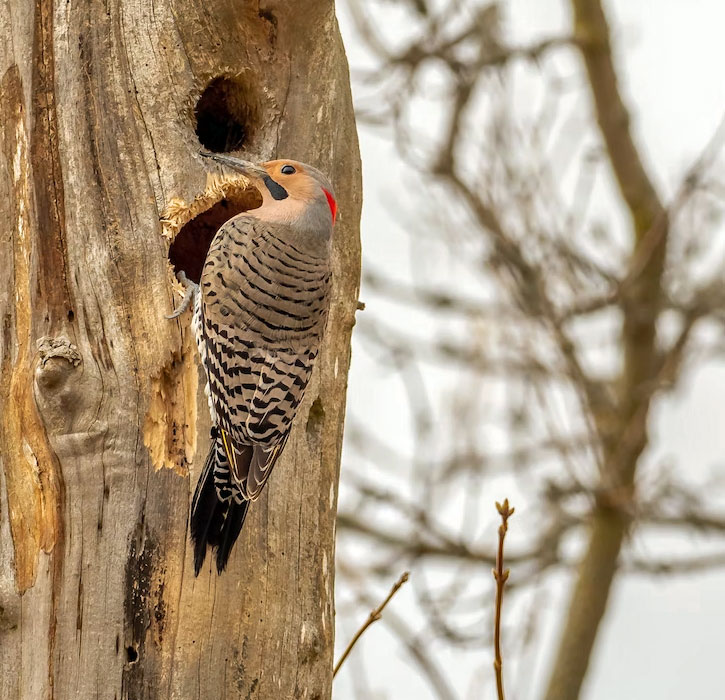
Out of all the woodpeckers in Virginia, the Northern flickers are likely the ones you see all the time.
They’re also known by many names, such as Red-shafted Flicker, Yellow Flicker, and Northern Flicker Picidae because their appearance slightly differ depending largely on where they live.
Northern Flicker Appearance
Northern flickers are big woodpeckers, They’re the second-largest Virginia woodpecker, and sized between a crow and a robin.
Norther Flickers are characterized by cool light brown plumage with hints of black stripes on their backs and wings, ending with all-black edges.
They also have slim head with a slightly-curved bill.
Depending on where they live, Northern Flickers could have the following features:
- black markings on their cheeks
- distinctive red streak on the head
- black, large crescent on their chests
Where to find Northern Flickers in Virginia
Northern Flickers are year-round Virginia woodpeckers. They’re known to stay in the state, even during the winter.
Northern Flickers live in cemeteries, parks, and other open habitats with trees.
They sometimes visit backyards as well and eat beetles, caterpillars, ants, young bats and termites.
7. Hairy Woodpecker (Dryobates villosus)
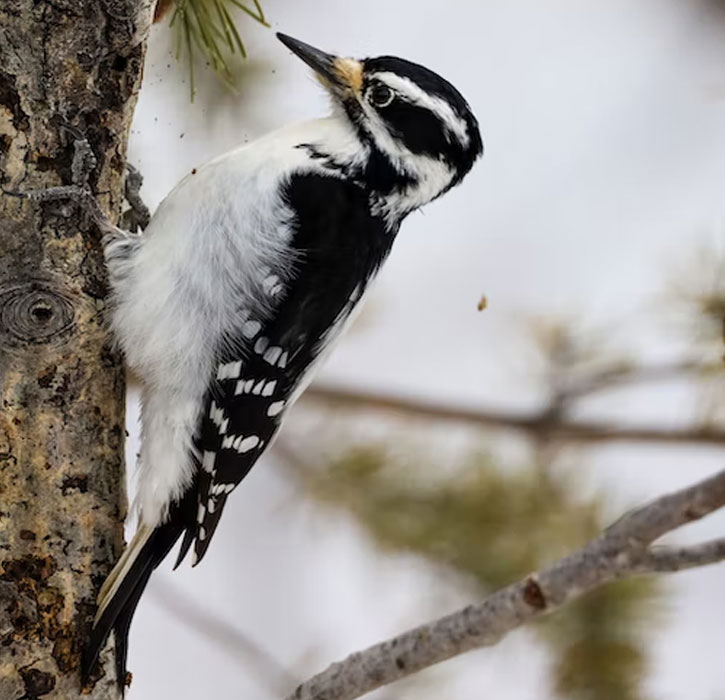
The hairy woodpecker definitely looks hairy! Very appropriately named.
Hairy Woodpecker Appearance
Hairy Woodpeckers look like a bigger version of Downy woodpeckers. Both species have a dramatically-contrasting black and white plumage with a large patch of white on their chests and underbellies.
Male Hairy Woodpeckers have a red streak on the back of their heads, while both genders have pale yellow patch near their pointy all-black beaks.
Where to find Hairy Woodpeckers in Virginia
Hairy Woodpeckers are common in Virginia and are seen all year in parks, suburbs, woodlands, and forests with dead wood and mature trees. They also don’t migrate during colder seasons.
8. Red-headed Woodpecker (Melanerpes erythrocephalus)
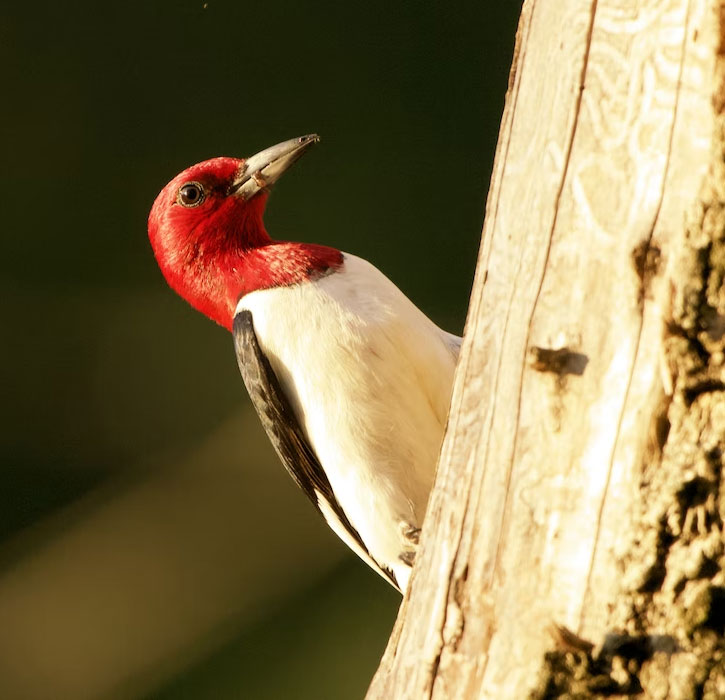
My favorite woodpecker in Virginia – the pretty Red-headed woodpecker has a bold all-red head that you’d likely identify if you get to spot one.
Red-headed Woodpecker Appearance
Red-headed woodpeckers are characterized by bold colors – their all-white bellies contrast quite perfectly with their black wings, then the deep, crimson red heads are the show-stoppers.
They are medium-sized – about the size of a hairy woodpecker.
Red-headed woodpeckers also have monochrome wings, a short (but powerful) bill and short one-color tail.
Where to find Red-headed Woodpeckers in Virginia
Red-Headed Woodpecker live year-round in Virginia in wetlands, forests, and other areas with plenty of trees.
Beyond Woodpeckers in Virginia
If your focus in birding is all about woodpeckers, check out the woodpeckers of Arkansas and woodpeckers of Alaska to get inspiration for your next birdwatching trip.
If you’re open bird-watching beyond woodpeckers and wanted to learn more about the birds of Virginia and nearby states, be sure to read all about:
- the winter birds of West Virginia,
- the song birds of Pennsylvania, and
- the owls of Kentucky.
